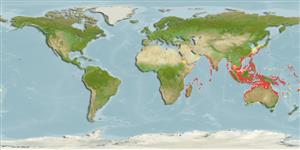Common names from other countries
Classification / Names / Names
Populärnamn | synonymer | Catalog of Fishes (gen., sp.) | ITIS | CoL | WoRMS
Environment: milieu / climate zone / depth range / distribution range
Ekologi
Revassocierade; djupintervall 0 - 70 m (Ref. 800). Tropical
Indo-West Pacific: East Africa to Japan and Australia.
Length at first maturity / Size / Vikt / Age
Maturity: Lm ? range ? - ? cm Max length : 2.0 cm WD hane/ej könsbestämd; (Ref. 800)
Maximum arm length: 20.0 cm. Occurs among branching corals and in crevices at depths of 0 to 70 m. Feeds by suspension feeding (Ref. 800).
Life cycle and mating behavior
Könsmognad | Reproduktion | Lek | Ägg | Fecundity | Larver
Members of the class Ophiuroidea are mostly gonochoric, others are protandric. Fertilization is external. Brooding is common, bursae is used as brood chambers where the embryos develop into juveniles and later crawl out from the bursal slits. Life cycle: Embryos hatch into free-swimming planktotrophic larvae and later metamorphose into tiny brittle stars which sink down the bottom where they grow into adult form.
Schoppe, S. 2000. (Ref. 800)
IUCN Red List Status (Ref. 130435)
CITES status (Ref. 108899)
Not Evaluated
Not Evaluated
Threat to humans
Harmless
Human uses
| FishSource |
Verktyg
Ytterligare information
Age/Size
Tillväxt
Length-weight
Length-length
Morfologi
Larver
Abundans
Internet-källor
Estimates based on models
Preferred temperature
(Ref.
115969): 24.2 - 29, mean 27.7 (based on 896 cells).
Vulnerability
Low vulnerability (10 of 100).
Price category
Unknown.
